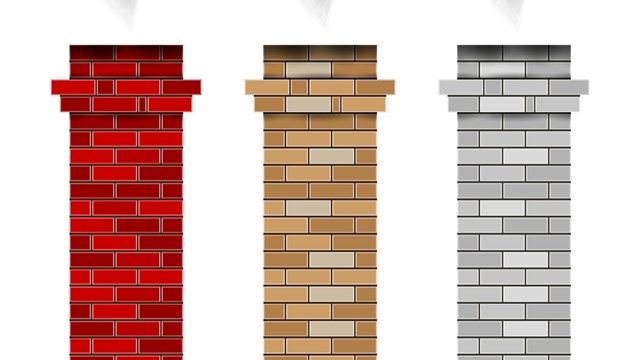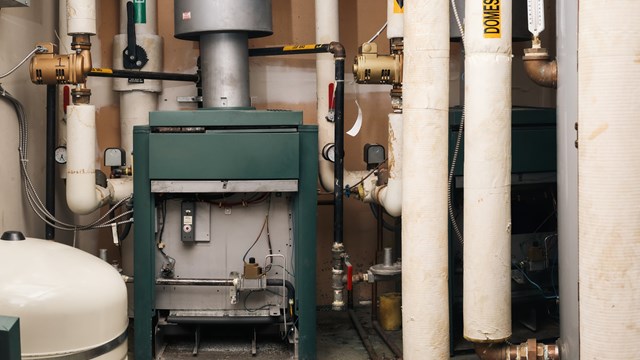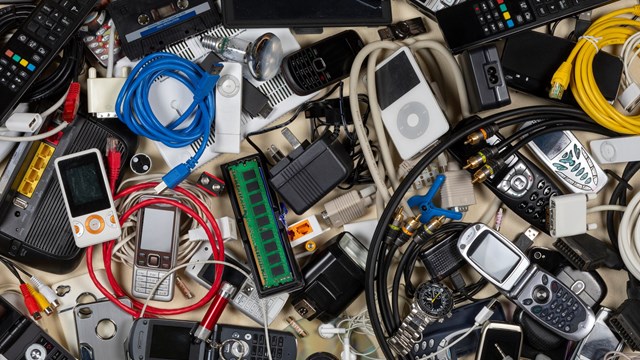
A sweep knows 'e's welcome
Wherever 'e goes"
--Chim Chim Cheree (from Mary Poppins)
Ah, to be a chimney sweep: face covered in soot, bristles in hand, dancing across the rooftops of London with Julie Andrews waiting below…
Well, maybe not. Armed with all manner of high-tech paraphernalia, from video inspection devices to mechanical draft inducers, today's chimney sweeps have come a long way from their Victorian predecessors. But they continue to play an important role in maintaining fireplaces and chimneys and in protecting the safety and welfare of the people who enjoy them.
If your condominium or co-op unit has a working fireplace, you're probably pretty happy about it. Masonry fireplaces, those archetypal icons of home and hearth, are more common in older buildings, while prefabricated, metal-lined fireplaces with modular, vented chimney systems—the kind that are just as likely to burn natural gas as wood—are typically found in newer construction.
Of course, lighting a fire in your home—wood-burning or otherwise—does carry certain risks. Chief among these are the potential for chimney fires and the possibility of carbon monoxide poisoning.
Fire in the Hole
Chimney fires result from the ignition of creosote, which is itself a by-product of solid fuel combustion. As the wood in your fireplace burns cheerily away, it releases a number of chemicals, including tar, which subsequently condense onto the interior of your chimney. (In multi-unit buildings, each fireplace vents through its own chimney, for safety purposes.) The resulting residue, which can be sticky, oily, flaky, or all three, is called creosote, and it is highly flammable.
In old-fashioned masonry chimneys, a creosote-fueled chimney fire can burn hot enough to melt mortar and crack terra cotta flue tiles. If wooden headers or other combustible materials abut those tiles, they too can catch fire, ultimately causing the entire structure to go up in flames. A good creosote fire can even buckle and warp the seams and joints of a stainless-steel chimney liner, leading to expensive repairs.
In the event of a chimney fire, you can try using a specially designed extinguisher, called Chimfex, to quell the blaze. But according to Ruthie Francisco of Windswept Chimney Services of Scotia, New York, the best course of action is to flee and seek help. "Call the fire department immediately and get out of the house," says Francisco, who is president of the New York Chimney Sweep Guild (NYCSG). "When in doubt, just run."
Francisco adds that even when creosote doesn't burst outright into flame, it can smolder for days. And as it does, it can expand considerably, thereby occluding the chimney. (In humid weather, contact between creosote and airborne water vapor can also lead to a relatively benign, if foul-smelling, condition known in the trade as "chimney breath.")
To minimize creosote build-up, make sure that your firewood has been adequately seasoned. Green, unseasoned wood produces relatively cool smoke, which only promotes creosote formation.
Cookin’ With Gas
Under ordinary circumstances, gas fireplaces don't generate creosote. But according to Royal Edwards, technical director for the National Chimney Sweep Guild (NCSG), even the fake log in a gas fireplace can cause trouble.
"It doesn't take much to affect the combustion process of the log," says Edwards, who explains that the presence of dust or animal hair—or even something as simple as a change in the position or orientation of the log—can lead to the unintended production of both soot and carbon monoxide.
Edwards says that wood fires can also generate carbon monoxide—most notably "At the end of the burning cycle, when you're basically burning charcoal." As a result, carbon monoxide intrusion is a potential danger with both solid-fuel and gas fireplaces. (Carbon monoxide detectors are required in all multiple and private dwellings in New York City.)
So, of course, are chimney blockages. Your chimney might not seem like a particularly inviting place to live, but many birds would disagree. A chimney that lacks a proper crown, or cap, can make an excellent spot for a nest. One species of bird called the “chimney swift” so enjoys nesting on the smoke shelves that lie behind fireplace dampers that it was named for its habit.
Unfortunately, an obstructed chimney is much less likely to pass smoke and carbon monoxide safely out of your home. Especially if that home happens to suffer from negative pressure—a condition in which air would prefer to flow into your unit rather than out of it.
Edwards estimates that some 75 percent of fireplace operation problems stem from negative pressure, particularly in newer buildings that are tightly constructed and which contain large numbers of mechanical fans designed to extract air for heating and ventilation purposes. Unless sufficient "make-up" air is somehow permitted back into the building, the air pressure in the vicinity of your fireplace can drop below the air pressure outside—causing smoke to be drawn in instead of out. And since the chimneys in multi-unit buildings are often located close to one another, you may even find smoke being drawn into your unit from your neighbor's chimney.
Fuel for the Fire
Creosote build-up can be minimized to some extent by burning only well-seasoned wood instead of green, unseasoned wood. And a mild negative pressure problem can sometimes be circumvented by rolling up a sheet of newspaper, lighting one end, and holding the resulting wick up by the open damper in your fireplace; eventually, the downward air flow should reverse itself.
But the best way to ensure that your fireplace and chimney are in safe working order and won't smoke you out of your home in the middle of the night is to bring in a professional chimney sweep for regular inspections and cleanings. (Edwards warns against relying on chemical “cleaning” logs, which not only release noxious and potentially irritating chemicals, but which only remove a fraction of the creosote that can accrete in a chimney.)
“We recommend annual inspections so that you know what's going on in your fireplace,” says Melissa Heeke, director of communications and marketing for the NCSG and communications director for the Chimney Safety Institute of America (CSIA).
While some states, like Oregon and the Carolinas, have their own certifying bodies, the CSIA is the only national certifying agency for chimney sweeps in the United States. The organization awards its Certified Chimney Sweep designation upon the successful completion of an exam based on its own Successful Chimney Sweeping manual, and on the National Fire Protection Association's NFPA 211 standards, which call for chimneys to be swept and inspected every year—or, in the case of wood-burning systems, after every cord of wood.
The NFPA 211 also specifies three levels of chimney and fireplace inspection and clearly defines what is required for each. (According to Heeke, the third and highest level of inspection may include demolition—e.g., tearing through a wall or removing a portion of the chimney. "You don't want to start with level three," she says.)
Team Sweep
Chimney sweeps can maintain their CSIA certification either by re-testing every three years or by earning continuing education credits at workshops and seminars conducted by the CSIA and by local organizations like the New York Chimney Sweep Guild. And while certification is not mandatory, sweeps must be licensed to operate in particular geographic areas.
"Down on Long Island, each county requires its own license," says Diane Pilger, of Chief Chimney Services in Smithtown, New York. And some towns in the Hamptons even impose their own local licensing requirements. (Chief Chimney Services is itself licensed to operate in Suffolk County by the Suffolk County Department of Consumer Affairs.) As a result, it's important to verify that your chimney sweep is not only properly trained—CSIA certification and membership in the NCSG or NYCSG are good signs—but properly licensed, as well.
Francisco recommends checking a prospective sweep's references, too; and seeking out a second or third opinion when a potential problem is identified. "Most chimney problems do not happen overnight," she says. "So always get more than one opinion."
Modern sweeps benefit from the availability of new technology. Sophisticated video inspection equipment, like the Estoban Corporation's Chim-Scan and Wohler's "Eye of the Viper" VIS 2000 system, can be used to accurately assess the interior condition of a chimney, revealing stress cracks in mortar joints and separation gaps in modular stainless-steel liners that might be invisible to the naked eye.
Not all progress is 100 percent beneficial, however. According to Francisco, the terracotta flue tiles that were traditionally used in masonry units after the turn of the century had a typical life span of 50 to 60 years. The stainless-steel liners that most often replace them—and that are commonly installed with today's prefabricated fireplaces—are made by a variety of manufacturers, but most companies only sanction the use of their own replacement parts, which have been tested and approved for use with their systems.
If and when those parts become unavailable, you may find yourself having to replace your entire chimney system, at considerable cost. Nonetheless, Francisco strongly advises against using "after-market" parts, even if they can save you money. "I would rather see people use the right parts and pay the extra thousands of dollars, as much as that hurts -- because otherwise, they're endangering their families," she says.
Another way to protect your home and family is to schedule regular chimney inspections. The initial inspection will generally begin on the roof, with an evaluation of the chimney installation and crown. After moving indoors and thoroughly inspecting the fireplace and flue—removing the log grate, examining the smoke shelf—the sweep can clean the chimney using high-powered vacuum cleaners and extensible stainless-steel brushes.
According to Pete Stone of United Chimney Corporation, which services the five boroughs, Northern New Jersey, and Nassau and Suffolk counties, cleaning a chimney in a mid- or high-rise building is no problem. The brushes used by professional sweeps are mounted on five-foot lengths of rod, each with female and male ends. However long a path they must snake through, a sweep can simply continue to add lengths of rod until he's swept the entire chimney.
While a typical inspection and cleaning can take anywhere from half an hour to one-and-a-half hours, the amount of time and money involved depends on location and the level of service required. United, for example, charges $49 for a standard inspection and cleaning in Queens, but $169 for the same service in Manhattan. An additional $39 is levied for each floor above the third that must be swept; and a video inspection costs an extra $225.
Lest you think that's too pricey, remember Francisco's warning: "Beware the cheap sweep." Properly trained and certified sweeps may cost more than amateurs, but they're worth it, especially considering how dangerous an improperly maintained fireplace and chimney can be.
If necessary, a professional sweep can even make repairs to damaged parts, or install specialized equipment like mechanical draft inducers, which are used to solve persistent negative-pressure problems. So while they may no longer be on a first-name basis with Mary Poppins, contemporary sweeps are still quite welcome—at least among those who take their fireplaces and chimneys seriously.
Alexander Gelfand is a freelance writer living in Queens.






Leave a Comment